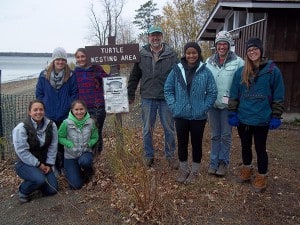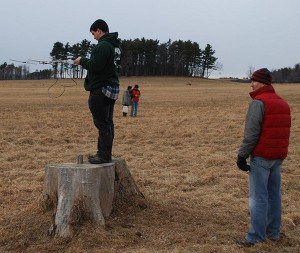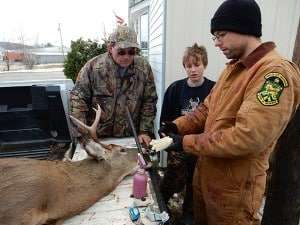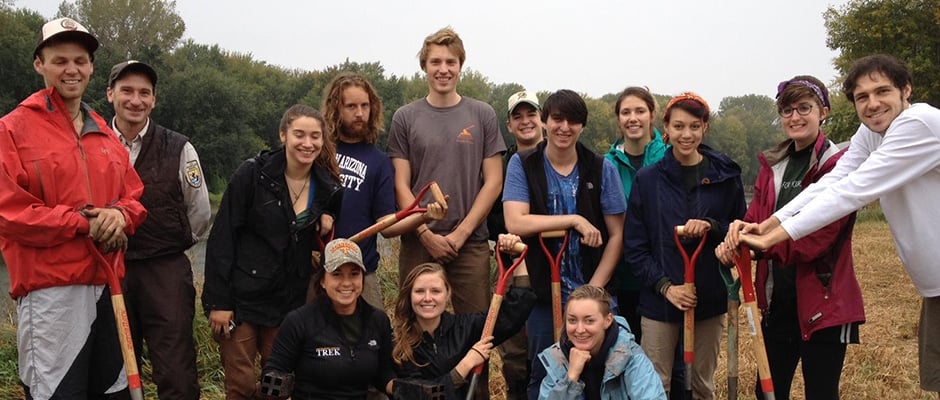Share this article
Students Pursue Career Goals by Volunteering, Networking
The University of Vermont (UVM) Student Chapter of The Wildlife Society has been actively involved in wildlife and fisheries related activities since 1973. Student members volunteer with many local organizations and agencies to gain experience in a variety of wildlife-related careers.

Chapter members with Vermont Fish and Wildlife Department biologist Steve Parren during the vegetation clean-up day to expose shale used for nesting by the state endangered spiny softshell turtle (Apalone spinifera).
Image Credit: Erin Sharkey
To enhance collaboration between the chapter and other natural resource professionals, the student chapter partners annually with federal, state, and non-governmental organizations to conduct habitat restoration and enhancement, ecosystem monitoring and inventory, wildlife research and training, and provide opportunities for natural resource professionals to present and share their findings to the greater UVM community and the public.
“The Wildlife Society at UVM provides many invaluable chances to explore possible career paths, from wildlife management, to research, to public relations. During such a pivotal time in their lives, students should know what options there are available to them to really make a difference once they graduate,” said Jessica Mailhot, a junior at UVM.
Specifically, the chapter partners each year with the U.S. Fish and Wildlife Service at the Missisquoi National Wildlife Refuge to enhance migratory songbird habitat by restoring native trees. In addition, they work collaboratively with the Vermont Fish and Wildlife Department to clear vegetation from Lake Champlain’s northern beaches, exposing the shale used for nesting by the state endangered spiny softshell turtle (Apalone spinifera).

Chapter members participating in a radio-telemetry workshop at Shelburne Farms, Vermont.
Image Credit: UVM TWS Member
“We are able to spend a beautiful day outside, cleaning the beaches where they [the turtles] nest, and even see some baby turtles brought by the biologists!” said Rhianna Sommers, a senior at UVM.
The chapter also participates in a BioBlitz where students and faculty rapidly identify and collect samples of all flora and fauna in various protected areas in the state. Other activities include training workshops on radio-telemetry and other field skills, guest lecturers with natural resource professionals, and attending local, regional, and national wildlife conferences.
The most anticipated annual event among members is assisting the Vermont Fish and Wildlife Department and Vermont Department of Health in the operation of biological check stations during Vermont’s deer and moose hunting seasons. Chapter members assist Fish and Wildlife biologists during the youth and modern firearm seasons in collecting information on the age, sex, and biomorphic condition of harvested animals. In addition, members collect blood sero-survey samples for the Department of Health to test for the presence of and monitor the distribution of antibodies for Eastern Equine Encephalitis (EEE) among Vermont’s ungulate populations.

Collecting information on the age, sex and biomorphic condition of a harvested deer at a biological check station during Vermont’s deer hunting season.
Image Credit: Matthias Surch
Amanda Adams, a junior at UVM, believes that working with the Vermont Fish and Wildlife Department and the Health Department provides students with an excellent opportunity.
“Working with state biologists at the biological deer check stations gave me great experience working with deer. It is also a great time to talk to the biologists about what they do,” said Adams.
Katie Stoner, a junior, agrees.
“My involvement with the University of Vermont Wildlife and Fisheries Society has allowed me the opportunity to pursue my career goals by volunteering to support collaborative efforts between research and conservation agencies,” she said. “These experiences provided invaluable skills preparing me for the professional world.
Adam Murkowski, deer project leader for the Vermont Fish and Wildlife Department, attributes the efforts of the chapter to the Department’s ability to enhance data collection from hunter harvested deer.
“Without the leadership and participation of UVM TWS members, the Vermont Fish and Wildlife Department would not be as capable of collecting biological data from hunter harvested deer either across the state or throughout the various deer hunting seasons each fall.”
For more information on the chapter’s upcoming events visit their website or Facebook.
Header Image:
Chapter members working with U.S. Fish and Wildlife Service at the Missisquoi National Wildlife Refuge to enhance migratory songbird habitat by restoring native trees.
Image Credit: Jed Murdoch








